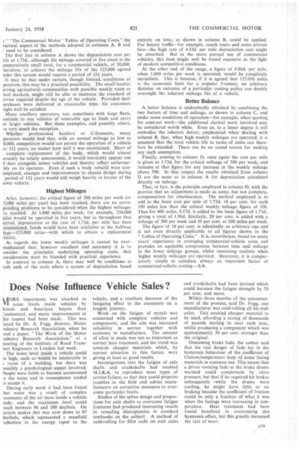Does Noise Influence Vehicle Sales ?
Page 63

If you've noticed an error in this article please click here to report it so we can fix it.
\4 ORE importance was attached to noise levels inside vehicles by hitish and American buyers than :lontinental, and many improvements in his respect had been made. This was tated by Dr. A. Fogg. director, Motor ndustry Research Association, when he Tad a paper, "The Work of the Motor ndustry Research Association," at a neeting of the Institute of Road Transmrt Engineers in London last week.
The noise level inside a vehicle could )e high, such as would be intolerable in room of a building, but there was nassibly a psychological aspect involved. ?tople were liable to become accustomed o the noise and in consequence tended o accept it.
During early work it had been found hat noise was a result of complex Tsonanee of the air mass inside a vehicle )ody, and the maximum level could -each between 90 and 100 decibels. On :..ertain makes this was now down to 85 lecibels, which represented a manifold -eduction in the energy input to the
vehicle, and a resultant decrease of the fatiguing effect to the occupants on a longish journey. Work on the fatigue of metals was concerned with complete vehicles and components, and the aim was increased reliability in service together with economy in manufacture. The amount of alloy in steels was not as important as correct heat treatment, and the trend was towards cheaper materials which, by correct attention to this factor, were giving at least as good results.
Investigations into the fatigue of axle shafts and crankshafts had enabled M.I.R.A. to reproduce most types of service failure, so that they could pinpoint troubles in the field and advise manufacturers on corrective measures to overcome particular faults.
Studies of the spline design and proportions for axle shafts to overcome fatigue fractures had produced interesting results in revealing discrepancies in standard textbooks on the subject. A method of cold-rolling for fillet radii on stub axles and crankshafts had been devised which could increase the fatigue strength by 70 per cent. and more.
Within three months of the announcement of the process, said Dr. Fogg, one manufacturer was cold-rolling all his stub axles. This enabled cheaper material to be used, affording a saving of thousands of pounds sterling in steel each year, whilst producing a component which was approximately 30 per cent, stronger than the original.
Discussing brake fade, the author said that the real danger of fade lay in the hysteresis behaviour of the .coefficient of friction/temperature loop of some facing materials in common use. This meant that a driver noticing fade as the brake drums warmed could compensate by extra pressure, but that if he required his brakes subsequently while the drums were cooling, he might have little or no braking because the coefficient of friction could be only a fraction of what it was when the facings were increasing in temperature. Heat treatment had been found beneficial in overcoming this hysteresis effect, but this greatly increased the rate of wear.




































































































